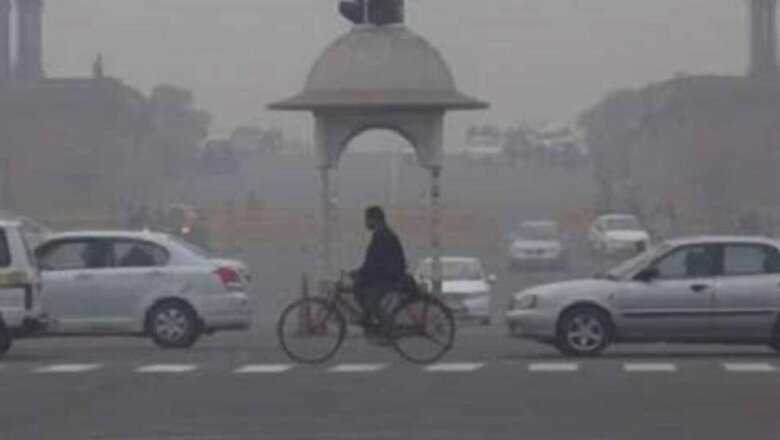
views
The air quality in Delhi may turn “severe” by midnight and escalate further by Friday morning if firecrackers are burnt, authorities said. This comes as the share of stubble burning in Delhi’s pollution rose to 25 per cent on Diwali, the highest this season so far.
According to Gufran Beig, the founder project director of SAFAR, the PM2.5 pollution in the capital may enter the “severe” zone by midnight even if there is 50 per cent of firecrackers emissions as compared to last year. Beig said the PM2.5 pollution will shoot up rapidly by Friday early morning with the air quality index (AQI) even crossing the 500-mark.
Earlier in the day, Delhi’s Diwali started with “very poor” air quality. At 8 am, the capital’s AQI stood at 341, up from 314 at 4 pm on Wednesday. The 24-hour average AQI was 303 on Tuesday and 281 on Monday.
Earlier this week, IMD had predicted that Delhi’s air quality is expected to be in the “very poor” category a day after Diwali. “Till November 4, air quality is expected to be in ‘poor’ category. It could dip to the ‘very poor’ category on 5-6 November due to northwesterly winds and bursting of crackers,” news agency ANI had quoted IMD scientist VK Soni as saying.
According to the Central Pollution Control Board’s data, the capital’s 24-hour average air quality index (AQI) stood at 382 on Thursday, up from 314 on Wednesday.
An AQI between zero and 50 is considered ‘good’, 51 and 100 ‘satisfactory’, 101 and 200 ‘moderate’, 201 and 300 ‘poor’, 301 and 400 ‘very poor’, and 401 and 500 ‘severe’. “The extremely calm wind conditions in Delhi and 25 per cent stubble share (fire count 2,293) are two major factors today,” SAFAR said.
‘Relief is expected only from the evening of November 7’
According to SAFAR model forecasts, the stubble burning share may increase to 35 per cent on Friday and 40 per cent on Saturday with the wind direction changing to northwesterly. Northwesterly winds carry smoke from farm fires in Punjab and Haryana towards the national capital.
“Relief is expected only from the evening of November 7, but AQI will fluctuate within ‘very poor’ range,” the air quality forecast agency said. An official from the India Meteorological Department had earlier said that model predictions do not indicate the AQI reaching the ‘severe’ category “even with higher emissions”.
Last year, the share of stubble burning in Delhi’s pollution had peaked at 42 per cent on November 5. In 2019, crop residue burning accounted for 44 per cent of Delhi’s PM2.5 pollution on November 1. Delhi Environment Minister Gopal Rai on Wednesday had urged the Centre to issue an advisory to Punjab, Haryana and Uttar Pradesh to completely stop stubble burning during the Diwali period so that people could breathe easy after the festival.
The contribution of stubble burning in Delhi’s PM2.5 concentration was 32 per cent on Diwali day last year as compared to 19 per cent in 2019. The contribution of farm fires in Delhi’s air pollution has remained low this season so far due to the record-breaking rainfall in October and “unfavourable” wind direction for transport of smoke from stubble burning.
SAFAR said “very calm” local Delhi wind conditions with little ventilation is expected for the next three days, which will be unfavourable for dispersion of pollutants. On October 27, the Delhi government had launched the ‘Patakhe Nahi Diye Jalao’ campaign to create awareness against the bursting of crackers.
Action is being taken under relevant IPC provisions and the Explosives Act against anyone found burning crackers under the campaign. On September 28, the Delhi Pollution Control Committee ordered a complete ban on the sale and bursting of firecrackers in the national capital till January 1, 2022.
According to the government, more than 13,000 kg of illegal firecrackers have been seized and 33 people arrested under the anti-cracker campaign.
Cracker Ban Goes Up in Smoke
Skies over Delhi hung heavy with smoke and its air quality inched towards severe category on Diwali night as people burst firecrackers in a blatant disregard to the government’s ban against it. The situation was aggravated further as the festivities coincided with seasonal farm fires, fumes from which invade the city around winter.
People from several parts of the city and its suburbs complained of itchy throat and watery eyes, as a layer of smog, the first episode this season, enveloped the environment. Residents of Lajpat Nagar in South Delhi, Burari in North Delhi, Paschim Vihar in West Delhi and Shahdara in East Delhi reported incidents of firecrackers bursting as early as 7 pm, despite the blanket ban in the national capital till January 1, 2022.
Several incidents of high-intensity cracker bursting were reported from Gurugram and Faridabad. The Haryana government had also imposed a ban on Sunday on the sale or use of all kinds of firecrackers in 14 of its districts in the National Capital Region, while curbs were put in other parts. Experts predicted the air quality here may plunge to the severe category by midnight owing to unfavourable meteorological conditions – calm winds, low temperature and low mixing height – and a poisonous cocktail of emissions from firecrackers, stubble burning and local sources.
The IMD said the first episode of fog in the capital reduced visibility at the Indira Gandhi International Airport and the Safdarjung Airport to the range of 600-800 metres in the morning. It continued to remain in the poor range of 800-900 meters in smog throughout the day due to calm wind conditions, senior IMD scientist R K Jenamani said.
The first episode of smog coincided with the share of farm fires in Delhi’s pollution increasing to the season’s highest at 25 per cent. The PM2.5 pollution in the national capital may enter the severe’ zone by midnight even if there is only 50 per cent of firecrackers emission as compared to last year, said Gufran Beig, the founder-project director of SAFAR.
(With PTI inputs)
Read all the Latest India News here

















Comments
0 comment